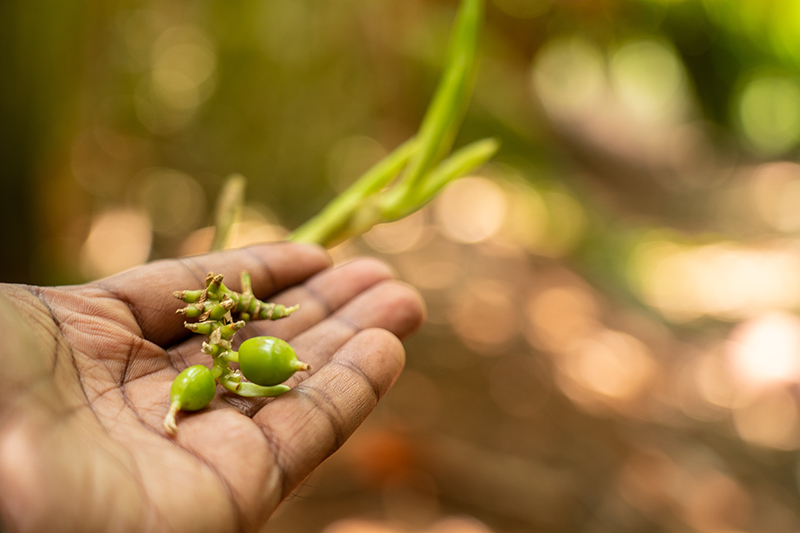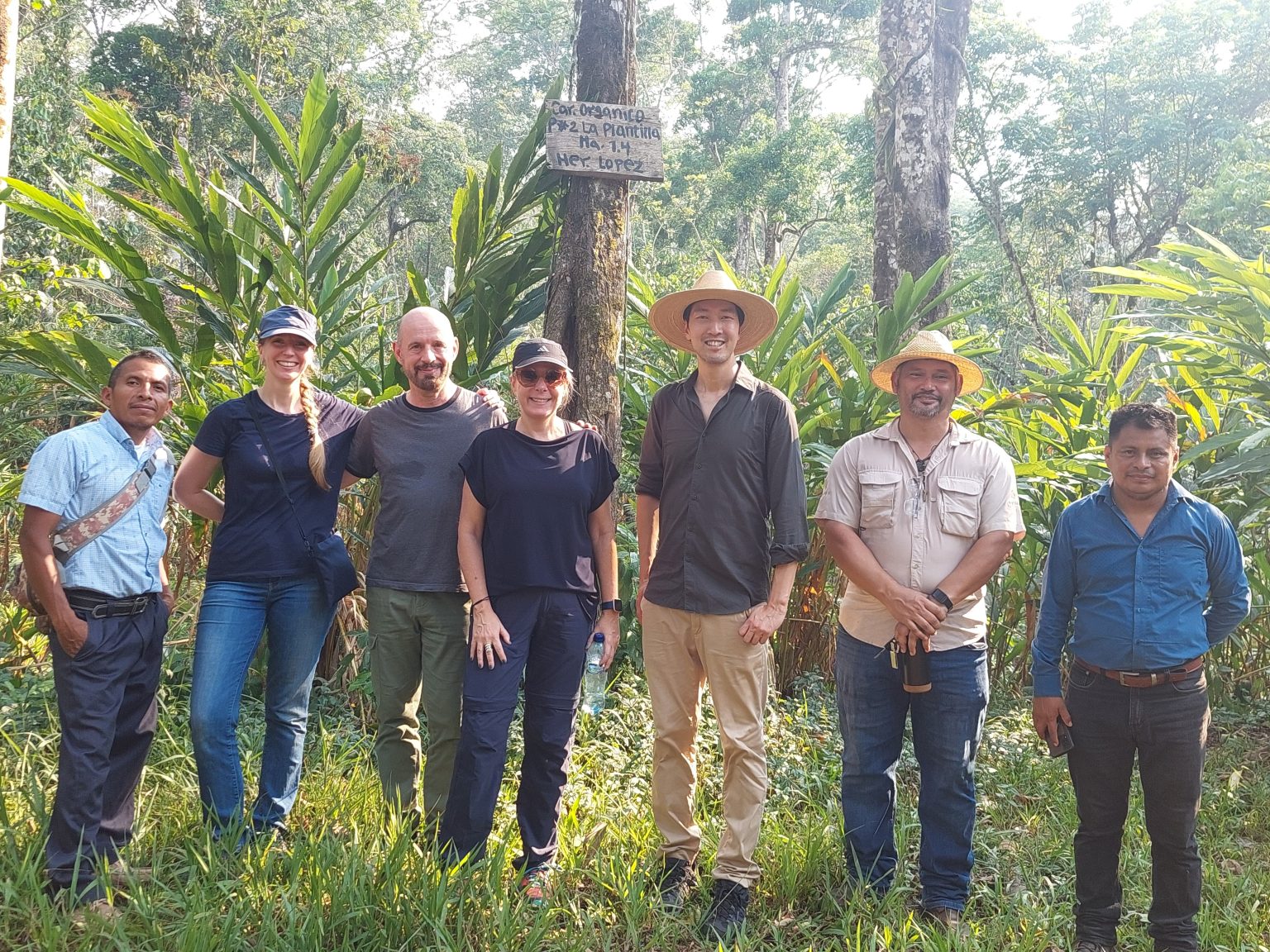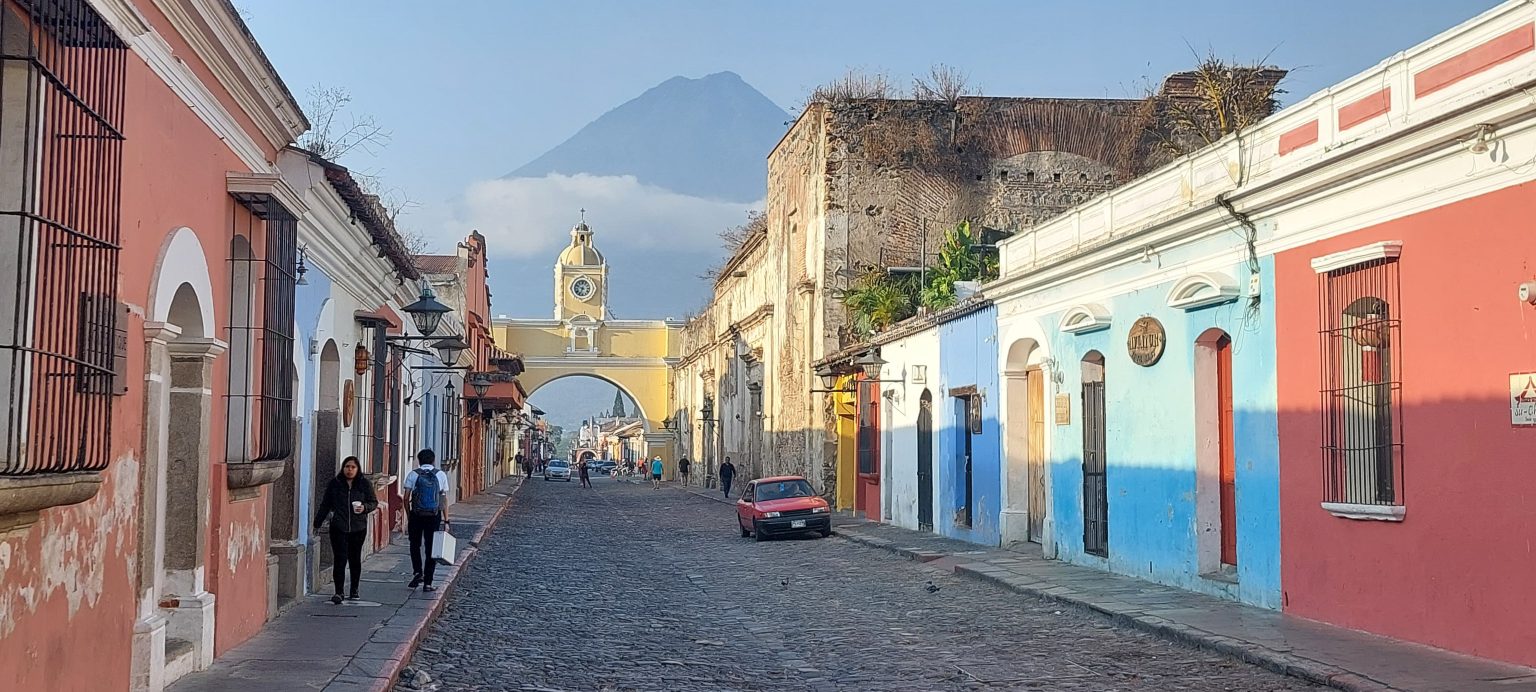Restore Together: a collaboration between Iberchem and Nelixia

It is the beginning of May. The air is warm and heavy. From Antigua Guatemala, a small plane takes us to Cobán in less than 40 minutes. By road, the trip would have taken us nearly six hours, mostly because of the heavy traffic. The land below us is uneven: small houses seem to hang on to the hills as if they were about to fall.
We landed in Cobán shortly before nine a.m. The trip to the cardamom plantation was far from over. The community Iberchem supports with Nelixia is located in a small village four hours north of Cobán. The dirt road to get there is bumpy and often gets impassable after a rainfall. We were all slightly dizzy when getting out of the car.
Three members of Iberchem travelled to Guatemala to familiarise themselves with the Nelixia project: Luz Vaquero, Global Fragrance Creation Director; Paco Miñano, Global Procurement Director; and Guillaume Audy, Sustainability Director. The project “Restore Together”, started in January 2023. At the time of the visit, two of the three steps of Nelixia’s first fundamental were completed: know the source and involve and respect. The third step is set to happen in the third year of the collaboration.

Nelixia implemented the project “Restore Together” with cardamom farmers. It aims to create a sustainable cardamom supply chain based on ethical relationships, transparency, biodiversity protection, and human empowerment. The first six months of the project were dedicated to identifying the direct beneficiaries. The community chosen by Nelixia was selected based on its organization and interest in Nelixia’s methodology. A total of 28 farmers joined the project for the first year.
[Guillaume Audy, Sustainability Director]
What I value about this project is that the benefits are bilateral: On one end, Iberchem’s financial contribution allows Nelixia to extend the footprint of its sustainability program to new communities. On the other hand, this collaboration allows us, thanks to the strong involvement of Elisa and her team, to create awareness among the employees, help us improve our working methods, and drive change at different levels within the company. I believe that, even though change and progress can happen using a top-down approach, they are much more qualitative and become truly embedded in a company if they come from the bottom up. Traveling to Guatemala allowed me to understand better the footprint of our activity and how, collectively, we can be more sustainable across our supply chain and our value chain in general.
My journey to Guatemala and the interactions with the communities have been an enriching experience. Not only did it introduce me to a new country and a new culture, but it also allowed me to connect with the individuals who represent the backbone of our work. It’s easy to forget about the human effort behind every drop of natural oil we use, or behind every product we consume in general, be it our clothes, our cell phone, or even the banana we have for breakfast. This experience has deepened my appreciation for the human contribution to our business operations.
After being invited to a traditional lunch at a local’s home, we headed towards the cardamom plantation. The air was hot and humid. A shy breeze barely made the leaves shiver. The plantation was not as we expected: instead of rows of plants aligned in perfect symmetry, they are grown naturally in the woods, scattered between trees and shrubs. “This is one of the many characteristics of a sustainable plantation,” said Fredy Rodriguez, sourcing director at Nelixia. “This way, the cardamom plants are protected from the sun, which can cause damage during extended periods of drought. Those are becoming more and more common now due to climate change.”
[Paco Miñano, Global Procurement Director]
I briefly met Elisa for the first time in 2019 in Bali during the IFEAT conferences. However, I got to know them better in 2022, in Vancouver at another IFEAT meeting.
What I like about the Nelixia team is the ease of communication and their transparency. To me, the word “sustainability” is becoming overused. It appears in the presentations of almost every company, but for them to walk the talk is something else. However, in the case of Nelixia, I have seen with my own eyes that “sustainability” is real. It is at the core of the company’s values and activities, and they strive to improve daily.
Through our collaboration with Nelixia, I have achieved a deeper understanding of our supply chain and what a sustainable supply chain should look like. I could witness all the work and complexity behind some of the raw materials that we use. Natural raw materials may seem more sustainable by definition, but in reality, it is not that easy.
When I learned that I was going to visit a cardamom plantation, I thought I was going to find something similar to what we see in Spain: fields planted following a geometry, plants making straight or curved lines in an orderly manner. But it wasn’t the case: there was no geometry at all. What we could see looked like a wild area. We were told that it is better for cardamom to coexist with larger trees to provide it with the shade it requires since the direct sun can damage it.
Later in this trip, we also went to El Salvador, where Peruvian balsam is extracted. I was fascinated by the tremendous effort that was made to obtain this magnificent product. Before, I knew little about it and only had a vague idea of its role in perfumery. Now I am aware that it is an exceptional and valuable product.
Know theSource, Involve and Respect, and Preserve, Protect and Promote Biodiversity are three of Nelixia’s fundamentals. “By promoting regenerative agriculture to protect the soils and involving technical assistance and training on good practices for the respect of the environment, among many other objectives, Nelixia has achieved cardamom yields higher than the country’s average, up to 1.4 times higher,” explained Fredy. In total, Nelixia work with 7 different ethnic groups in Guatemala and Honduras: Q´eqchi, Kakchiquel, Mam, Pocomchí, Uspanteko, Lenco and Chorti. Altogether, they represent more than 2,000 cardamom producers in Guatemala.
After a few hours of walking through the plantation, we hit the dirt road once again and drove back to our hotel in San Pedro de Carchá, a small community located just outside of Cobán. “We must leave before 4 p.m., otherwise it may start to rain, and it would take us forever to go back… if we can go back!” exclaimed Fredy. Luckily, it didn’t rain and we reached our hotel slightly after dusk without any problem.
The next day we woke up early to visit one of Nelixia’s collaborators to learn more about the supply chain, and upstream operations. The sun was barely up when we reached their office located in a large warehouse. Inside, a strong scent of fresh “achote” and cacao lingered in the air. Through a dynamic conversation, we again witnessed the good relationship Nelixia has with its business partners and the transparency of their operations. We quickly feasted on a snack made of homemade tortillas before heading back to the car with Fredy. This time we were on our way to El Salvador, where we would discover the production process of Peru Balsam. This, however, is another story!
[Luz Vaquero, Global Fragrance Creation Director]
Cardamom is a versatile ingredient. It is highly appreciated in food, for example; in India, it is chewed and worldwide it is widely used in infusions and also in baking. In the fragrance sector, it is used especially in fine perfumery. You could also use it in other applications, but if I had to choose one it would be fine perfumery. It blends very well with citrus and spicy notes. In oriental perfumery, it is a good ally of amber and oud.
What strikes me the most about Guatemalan cardamom is its fresh and spicy smell. Unlike other varieties, Guatemalan cardamom is very enveloping, and its freshness is transmitted as soon as you smell it. Shortly after, you begin to smell its spicy notes which can increase over time. When you wear it, cardamom has a very pleasant warming effect.
I have learned many things during this trip. Every perfumer should experience a similar experience at least once in their career. I think that it is important to know and understand the effort and dedication behind each perfumery ingredient. It is not just an essential oil, it is something much more precious. In fact, I learned that those who are dedicated to its cultivation refer to the inside of the seed as gold because for them it is very valuable. The care and dedication they put into both the cultivation of the raw material and the oil production process is incredible, all with a deep respect for nature. Now, I value even more every drop I add to my creations.
Overall, this trip was filled with great surprises. One of them was the cultivation methods. I first thought the crops would be in a field, similar to the crops we have in Europe. However, you have to literally go into the jungle to see the plantation. There is no field with extensive cultivated land. On the contrary, as we are speaking of sustainable farming methods, the farmers grow the cardamom plants between the native vegetation. This way, a more sustainable crop is achieved using trees to shade the cardamom plant so that it doesn’t dry out.
One of the things that I liked the most about this trip was meeting the producers and farmers. The area where cardamom is grown is very difficult to access and the producers belong to indigenous Mayan groups with a culture very different from ours. They normally don’t have much interaction outside of their communities, so I really appreciated that they let us into their homes, their fields, and shared with us part of their daily lives. Learning about their concerns, their aspirations and their point of view has been very valuable to me.
After six intensive days traveling across the countryside of Guatemala and the coast of El Salvador, our trip came to an end. Back in Antigua, we enjoyed one last meal with Elisa and Jean Marie before packing our suitcase and boarding the plane to come back home. Thanks to the generosity and kindness of the team of Nelixia and the communities we visited, we learned more than we expected. All of this knowledge was transmitted to the members of our teams at home and will eventually be diffused across the company.
[Guillaume Audy, Sustainability Director]
Beyond KPIs and certification, awareness and employee knowledge are key to progress and building a real foundation for our sustainability program. To do so, I think it is important to witness and to live real experiences. This was the aim of this trip. I am thankful to rely on partners such as Nelixia to support us in doing so. I hope this is only the beginning and that similar opportunities will eventually cross our path.

Did you know?
Cardamom (Elettaria cardamomum), native to India, was brought to Guatemala more than 100 years ago and grows in the very fertile lands of Las Verapaces, Huehuetenango, Quiche, and Izabal regions.
Cardamom is a shrub with leaves of 2 to 3 meters high. The fruit grows at the bottom of the plant.
Guatemala is the world’s largest producer of cardamom pods. More than 350,000 families cultivate that crop on an estimated surface of 63,000 hectares.
